Reptilicus (1961)
Directed by: Poul Bang
Written by: Ib Melchior, Sidney W. Pink
Starring: Ann Smyrner, Asbjørn Andersen, Bent Mejding, Povl Wøldike
Denmark
AVAILABLE ON BLU-RAY AND DVD
RUNNING TIME: 96 mins/ 81 mins
REVIEWED BY: Dr Lenera, Official HCF Critic
SPOILERS!
A drilling project in Lapland unearths the tail of a prehistoric dinosaur. The remains are taken for study at the Denmark Aquarium in Copenhagen, where it’s preserved in a cold room for scientific study. Professor Otto Martens, who is in charge of the Aquarium, dubs the reptilian species Reptilicus upon a reporter’s suggestion. When an assistant leaves a freezer open, the tail thaws and starts regenerating. A lightning storm finally brings the creature back to life and it smashes out of the lab and goes on a rampage….
Reptilicus has a reputation as being a really shoddy monster movie, and stills from the film of the astoundingly fake looking title creature seemed to back that up for me. Indeed, I will tell you now – you probably won’t find a film with a more unconvincing giant monster, with its near lack of mobility – we hardly ever actually see it move a significant distance, though we rarely see more than its head and neck either – its totally inexpressive face, and the immense amounts of scratches on the screen whenever there’s a close-of it because of the shoddy blue screen process used. Yet it’s hard to be too down when the Danes had never made a film like this before and the budget was clearly absurdly low, unlike something like The Meg which had a decent budget yet couldn’t make its blurry CG creation look much good. And what is essentially a Danish semi-remake of The Beast From 20 000 Fathoms with maybe a few nods to the Japanese film featuring Godzilla and his friends isn’t badly done in some other aspects, especially in the first half, though of course the writing, at least in the English language version, is at quite a low level and has a few howlers. On the other hand an obvious quirkiness that you would probably expect survives much of the tampering for an American audience – and boy was with film tampered with. In fact there’s even been a film book about the making of the movie.
It was produced by American International Pictures and Denmark’s Saga Studio, and Ib Melchoir’s script used some elements that were in his screenplay for The Volcano Monsters, which was to utilise some footage from the second Godzilla film Godzilla Raids Again in a new story. Eventually that film came out as Gigantis The Fire Monster, just a re-edited version of the Japanese original. Shot in and around Copenhagen, Sjælland, and Jylland, Reptilicus was shot twice, once in Danish directed by Poul Bang, and once in English directed by Sidney W. Pink using the same cast except for Bodil Miller, who couldn’t speak English so was replaced by Marlies Behrens. AIP thought it unreleasable, so got Melchior to substantially re-edit the film, including removing poor shots of Reptilicus flying [these can be viewed on YouTube and indeed they do look pretty dreadful] a musical segment, and cutting down the romance, while some sequences were re-edited so shots were in a different order or removed to make scenes work better. It seems that some shots unused in the Danish version made their way into the American cut too. I haven’t seen the 15-minute longer Danish version, but it appears that in this instance all this meddling may have improved the film. But Pink was angry at the changes and threatened AIP with a lawsuit which was then dropped after Pink and some others viewed the English-language version. However, he was enraged again when he read the paperback novelization by Dean Owen and found it to be full of sexual content, resulting in him suing the publisher, Monarch Books.Much more successful in Denmark than elsewhere, the film was intended to be remade by Pink in 2001, but he died before he could get it off the ground.
Like many of the Toho monster movies, there’s quite a large number of main characters and some of them get barely enough screen time. Our hero is Svend Viltorft, a miner who, after providing some scene-setting narration and featuring in a rather good opening in which blood comes out of a pipe followed by the film’s title [but no other credits], is later able to join the military in zooming around after Reptilicus. He’s soon joined by Prof. Otto Martens, Dr. Peter Dalby and journalist Hans Carlson [who soon disappears from the film] in aiding the digging up and transporting of the remains he finds. Back in Copenhagen, we find that Martens has a daughter Karen whom he asks to pick Svend from the airport. “How will I know him?” she asks to which Dad replies: “Since when must I tell you how to find a man?” She can’t keep her hands off lucky Svend but when she offers to show him around the city Dr Dalby strangely gets his other, almost as pretty, daughter Lisa to “chaperone” them. Sadly we never see what happens when the threesome go out [shame], and Karen then disappears for 45 minutes or so by which time her and Svend seem to be “together” so obviously some footage is missing here. Meanwhile American Gen. Mark Grayson has been sent to keep an eye on things and he’s not happy at being where he is, not even really melting when UNESCO scientist Connie Miller also shows up and Capt. Einer Brandt decides to show the two of them around. We do see some of this trip, and it’s like watching some kind of advertisement for the Danish Tourism Board as Einer points out all the landmarks and they finish up in a club where someone sings a song called Tivoli Nights.
This all probably sounds a bit dull if you’re just waiting for the monster to come to life, though some of the scenes at the lab with the regenerating tail are quite suspenseful despite the very sparse set design, with a nice moody atmosphere, good use of darkness, and the reviving creature being barely shown, maintaining a bit of mystery. The bit when the door isn’t left shut properly is particularly well handled with nice inter-cutting between a clock, a dial showing the rising in temperature, and a lab window. Reptilicus’s largely unseen escape during thunder is also quite good. None of this is anything special, but some of it is rather better done then I certainly expected. However around half way through we get our first full glimpse [well, his head and neck anyway] of Reptilicus, and I reckon that most cinema-goers in 1962 will have chuckled too, especially when he eats a superimposed paper cutout of a farmer [I’m not joking]. The military soon mobilise and chase Reptilicus into the water, but you know he’ll soon surface again. It’s perhaps not that odd that this army seems so tiny considering the budget, and considering the American involvement in the film nor is it perhaps odd that the Americans seem to immediately be in charge here, the Danes obviously not trusted to do the job themselves. There’s a bit of objection to the military attempting to blow Reptiilicus to smithereens, but with one exception it’s because it may just result in more regeneration, so they have to find another way – though it ends up just being a variant on the method in The Beast From 20 000 Fathoms.
Reptilicus is laughably described as a cross between a Diplodocus and an amphibious reptile despite being basically a snake-like creature with a vaguely Oriental dragon-like head [with just six teeth] and little [and unused in the English version] wings. The major problem with this film is that they clearly tried to do far too much with the limited resources that they had. The Reptilicus footage tends to consist of fairly quick shots and the rampage through Copenhagen only shows a few structures being wrecked despite us being shown evidence of mass destruction afterwards. The monster’s annihilation of a naval fleet is only shown as a few shots from a news report, and no it certainly doesn’t destroy the Golden Gate Bridge despite what the American poster suggests. Then again Reptilicus barely looks capable of destroying anything. I doubt he’d survive more than a few seconds against Godzilla.. He’s obviously a puppet but they could surely have done more to provide the illusion that he’s moving, while the model work is extremely simple and lacking in detail. For the American version, they animated some shots of red acid coming out of his mouth to presumable make Reptilicus seem more dangerous, but of course it’s never seen to actually hit anyone and nobody mentions it. At least there’s a few flashes of the red stuff including a severed monster arm sinking to the bottom of a lake. On the other hand there’s a few badly out of focus shots of buildings which surely couldn’t be down to the Blu-ray transfer. Did nobody care to correct or remove them when the film came out? And one can’t help but laugh when a drawbridge is raised quickly so that loads of cyclists plunge into the sea.
The dubbing isn’t as bad as some that I’ve seen, Bent Mejding has a likable presence as Sven despite not really having a character to play, while Carl Ottosen hams it up enjoyably as Grayson. His character gets an odd moment when he also becomes the narrator. Les Baxter wrote the entirely forgettable score [well, for the American version] which is typically heavy handed – even a somewhat romantic theme suffers from over-orchestration – though typical of films like this of the time. In general though I didn’t find Reptilicus to be that bad. I’ve certainly seen worse movies of this sort [The Beginning Of The End anyone?]. Many of the effects do look really primitive even by the standards of the time, but as I said at the beginning of this war one can’t criticise the filmmakers too much for trying their best with what little they had, even if maybe they should have had a look at how some of the other films around the time achieved things. Unlike Tentacles, Reptilicus has plenty of charm too which helps to carry it through its dodgier moments.

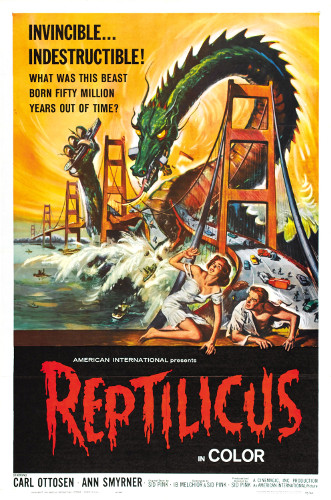
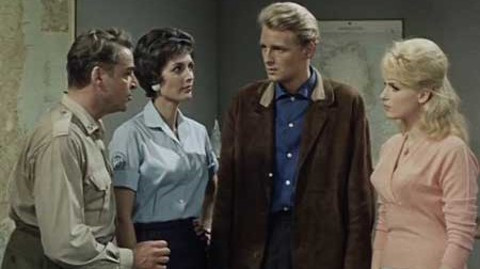
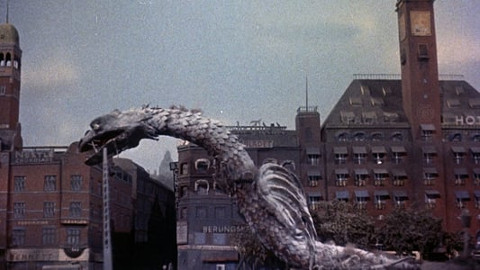




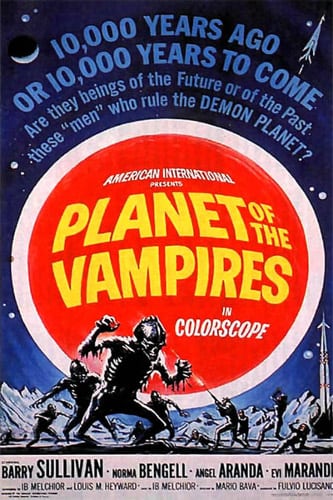
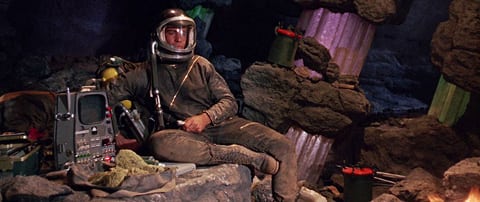
Hi…I recall seeing this movie in the theater in my youth. Why do I recall that blue fire shot out of either Reptilicus’ eyes or mouth? Am I crazy? it has, after all, been about 60 years!!